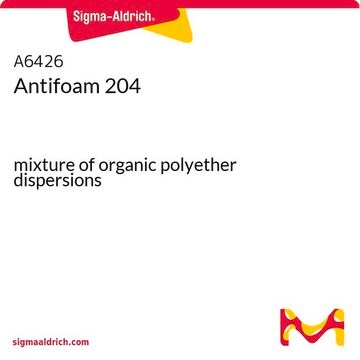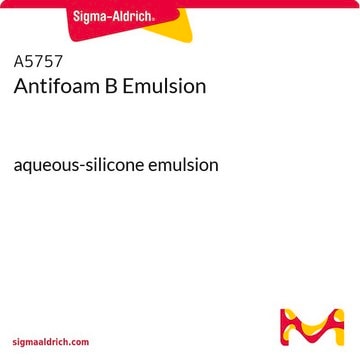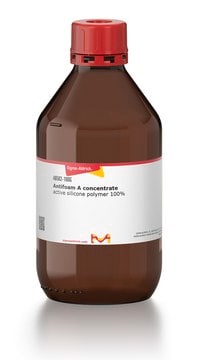A8011
Antifoam C Emulsion
aqueous-silicone emulsion
Sinónimos:
Antifoaming Agent Emulsion
About This Item
Productos recomendados
biological source
synthetic
form
emulsion
contains
emulsifier
technique(s)
cell culture | hybridoma: suitable
microbiological culture: suitable
mp
0 °C (32 °F)
Categorías relacionadas
General description
Application
- as a supplement in RO-H2O and a chemically defined culture medium to determine volumetric mass transfer coefficient (kLa) of mammalian cell culture
- as a component of feed medium,
- as a steam-sterilized antifoaming agent in a biocontroller for pH-stat fed-batch cultivations
- as a supplement in fed batch medium to mimic the typical large-scale cultivation conditions
Features and Benefits
- Minimizes compatibility issues with biological systems
- Highly effective defoamer at low concentrations
- Highly effective and versatile silicone defoamer
Other Notes
signalword
Warning
hcodes
Hazard Classifications
Eye Irrit. 2 - STOT SE 3
target_organs
Respiratory system
Storage Class
10 - Combustible liquids
wgk_germany
WGK 3
flash_point_f
Not applicable
flash_point_c
Not applicable
ppe
Eyeshields, Gloves, type ABEK (EN14387) respirator filter
Certificados de análisis (COA)
Busque Certificados de análisis (COA) introduciendo el número de lote del producto. Los números de lote se encuentran en la etiqueta del producto después de las palabras «Lot» o «Batch»
¿Ya tiene este producto?
Encuentre la documentación para los productos que ha comprado recientemente en la Biblioteca de documentos.
Los clientes también vieron
Nuestro equipo de científicos tiene experiencia en todas las áreas de investigación: Ciencias de la vida, Ciencia de los materiales, Síntesis química, Cromatografía, Analítica y muchas otras.
Póngase en contacto con el Servicio técnico













